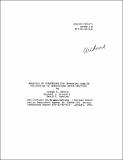Analysis of strategies for improving uranium utilization in pressurized water reactors
Author(s)
Sefcik, Joseph A.; Driscoll, Michael J.; Lanning, David D.
DownloadEL_TR_1980_032.pdf (8.784Mb)
Other Contributors
United States. Dept. of Energy. Division of Energy Technology.
Metadata
Show full item recordAbstract
Systematic procedures have been devised and applied to evaluate core design and fuel management strategies for improving uranium utilization in Pressurized Water Reactors operated on a once-through fuel cycle. A principal objective has been the evaluation of suggested improvements on a self-consistent basis, allowing for concurrent changes in dependent variables such as core leakage and batch power histories, which might otherwise obscure the sometimes subtle effects of interest. Two levels of evaluation have been devised: a simple but accurate analytic model based on the observed linear variations in assembly reactivity as a function of burnup; and a numerical approach, embodied in a computer program, which relaxes this assumption and combines it with empirical prescriptions for assembly (or batch) power as a function of reactivity, and core leakage as a function of peripheral assembly power. State-of-the-art physics methods, such as PDQ-7, were used to verify and supplement these techniques. These methods have been applied to evaluate several suggested improvements: (1) axial blankets of low-enriched or depleted uranium, and of beryllium metal, (2) radial natural uranium blankets, (3) lowleakage radial fuel management, (4) high burnup fuels, (5) optimized H/U atom ratio, (6) annular fuel, and (7) mechanical spectral shift (i.e. variable fuel-to-moderator ratio) concepts such as those involving pin pulling and bundle reconstitution. The potential savings in uranium requirements compared to current practice were found to be as follows: (1) O0-3%, (2) negative, (3) 2-3%; possibly 5%, (4) "15%, (5) 0-2.5%, (6) no inherent advantage, (7) 10%. Total savings should not be assumed to be additive; and thermal/hydraulic or mechanical design restrictions may preclude full realization of some of the potential improvements.
Date issued
1981Publisher
Cambridge, Mass. : Massachusetts Institute of Technology, Energy Laboratory, 1981
Series/Report no.
Energy Laboratory report (Massachusetts Institute of Technology. Energy Laboratory) no. MIT-EL 80-032.MITNE ; no. 234.
Keywords
Pressurized water reactors., Uranium., Nuclear fuels., Nuclear fuel elements.